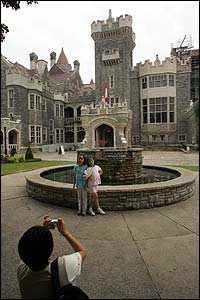| Jul. 9, 2005. 01:00 AM | ||
| How a
Casa crumbles Dusty effort to restore tourist magnet Casa Loma long a victim of local neglect CHRISTOPHER HUME A man's home is his castle; in Sir Henry Pellatt's case, it was Casa Loma. | ||
| Built between 1911 and 1914, it was ˇ and still is ˇ the grandest residence ever constructed in Canada. With 98 rooms, it was conceived on a scale that dwarfed everything else around it. These days Casa Loma is one of Toronto's most popular tourist attractions. Since the city took over Pellatt's castle for non-payment of taxes and handed it over the Kiwanis Club in 1936, little has changed at the "house on the hill" above Spadina Rd. Now people are beginning to wonder if the Kiwanis Club is the best choice to run Casa Loma. The well-intentioned service club uses its portion of the profit to support charitable projects, but many feel that it has failed to take advantage of the place.Last year a special committee was formed to examine the situation. It will present its report to City Council this fall. But from the beginning, Torontonians have been ambivalent, even hostile, about Pellatt, his boundless ambition and his famous folly.When the business empire he created collapsed in the early 1920s, they smirked and rubbed their hands in glee. After Pellatt was forced to abandon Casa Loma in 1924, the contents of his castle were auctioned off in a manner apparently calculated for maximum humiliation. |
RON
BULL/TORONTO STAR
Casa Loma
is one of Toronto's top tourist attractions, drawing about
400,000 people a year most of them out-of-town visitors. The
city is spending millions of dollars on a restoration program,
and now a special panel is taking a harder look at how the
90-year-old structure is managed and
maintained.  | |
The sale,
described at the time as "the auction of the century," lasted a full four
days. Property that Pellatt had collected at a cost of $1.5 million was
sold for $131,600. Torontonians couldn't have been more delighted.
What Torontonians chose to overlook was that Pellatt brought them
kicking and screaming into the 20th century.
It was Pellatt who pioneered hydroelectric power in Canada and who
laid out much of the public transit system what would become the TTC.
But even after Pellatt was gone, his castle remained.
The city had no idea of what to do with it. Various schemes were
tried and failed until, finally, in 1936 the Kiwanis Club took over.
Already the building was falling into disrepair and the club spent a year
whipping the place into shape. When it opened to the public in '37, it was
an instant hit.
The deal worked out calls for the Kiwanis to operate the facility
and maintain the interior. The city, which owns the building, is
responsible for the exterior. Under the terms of the agreement, the city
receives 32.5 per cent of the box office and 7 per cent of other revenues
ˇ about $1 million annually.
But lately there have been signs of trouble. By the `90s, the
exterior of the castle was literally falling apart and there was a feeling
it was growing a little tired.
Then, last year, the Casa Loma Advisory Committee (CLAC) was
struck.
"The city has viewed Casa Loma simply as a cash cow," says CLAC
chair Ron Kanter, a Toronto lawyer and former MPP. "We're saying that the
castle has been neglected for too long. There are varying views of what to
do but many think it could be better. There are many ways of adding to the
tourist experience. The Kiwanis is doing what the city asked them to do,
but the city should be asked to do more. The city really should be doing a
better job with sites like Casa Loma, but running a historic site is a
challenge. We intend to propose changes to improve the operation and draw
of the castle."
According to architect Charles Hazell, who has headed the
ongoing restoration of the crumbling castle since 1997, the building was
in terrible shape when work began seven years ago.
"Some sections are so damaged you can push them over with your
hands," observes Hazell, crumbling bits of the exterior with his fingers.
"There was danger of imminent collapse. After our first inspection, we put
up caution tape immediately. It's amazing nobody was hurt by falling
debris."
As Hazell explains, the problems with the exterior go back to the
1980s when, to delay proper maintenance, the city had the outside walls
coated and painted over. This had the effect of trapping moisture inside
the blocks. It froze, expanded and burst the cast stone to pieces.
"Pellatt's architect, E.J. Lennox, used a product called Roman
Stone, a precursor of precast concrete," Hazell says. "It was a type of
solidified mortar. It was superb at handling our climate and it can be
carved. The problems happened because it was coated with Portland cement
and latex paint. You can see in the areas that weren't touched the Roman
Stone is doing just fine."
Ever the entrepreneur, Pellatt had seen Roman Stone in the U.S. and
hoped to introduce it to Canada as a building material of the future.
Whatever other intentions he had for Casa Loma, it was also to be a
showcase of this new technology.
"It is a lovely material," Hazell insists. "But we wrecked it."
| ||